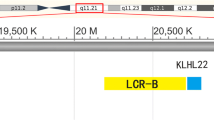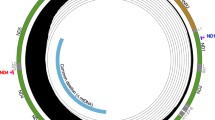Abstract
Copy number variation (CNV) reflects a gain or loss in the number of copies of DNA fragments in a genome. CNV is common in genetic diseases and is known to cause particular neurodegenerative diseases. We developed a dNTP-limited, competitive PCR technique to identify relative copy number differences between a reference and one or more target genes. Suitable fragments with single melting domains, well-separated melting temperatures, and no common homologs were identified by uMelt melting curve prediction software. Relative product amounts were maintained during multiplex PCR into the plateau phase by limiting dNTPs. After PCR, fluorescent melting curve analysis was automatically performed with the saturating DNA dye, LCGreen® Plus. Exponential background was removed, melting curves were plotted as negative derivative melting peaks, and the reference peak was normalized by both position (temperature) and height of each peak. With the reference peak normalized, the height of the target peaks established the copy number order that can be quantified against standards. Using chromosome X variation, the best dNTP concentration to distinguish copy numbers was about 6 μM each and CVs of about 1% were obtained with high-resolution melting analysis. The method was applied to spinal muscular atrophy, trisomies 13, 18, and 21, and cystic fibrosis gene deletions. The method is rapid, economical, and closed tube, and can be used for diagnosis or confirmation of copy number differences identified by high-throughput screening methods.
Access this chapter
Tax calculation will be finalised at checkout
Purchases are for personal use only
Similar content being viewed by others
References
Stankiewicz P, Lupski JR (2010) Structural variation in the human genome and its role in disease. Annu Rev Med 61:437–455
Lefebvre S, Burglen L, Reboullet S et al (1995) Identification and characterization of a spinal muscular atrophy-determining gene. Cell 80(1):155–165
Koenig M, Hoffman EP, Bertelson CJ et al (1987) Complete cloning of the Duchenne muscular-dystrophy (DMD) cDNA and preliminary genomic organization of the DMD gene in normal and affected individuals. Cell 50(3):509–517
Dendunnen JT, Grootscholten PM, Bakker E et al (1989) Topography of the Duchenne muscular-dystrophy (DMD) gene—FIGE and cDNA analysis of 194 cases reveals 115 deletions and 13 duplications. Am J Hum Genet 45(6):835–847
Gillard EF, Chamberlain JS, Murphy EG et al (1989) Molecular and phenotypic analysis of patients with deletions within the deletion-rich region of the Duchenne muscular-dystrophy (DMD) gene. Am J Hum Genet 45(4):507–520
Forrest SM, Smith TJ, Cross GS et al (1987) Effective strategy for prenatal prediction of Duchenne and Becker muscular-dystrophy. Lancet 2(8571):1294–1297
Taioli F, Cabrini I, Cavallaro T et al (2011) Inherited demyelinating neuropathies with micromutations of peripheral myelin protein 22 gene. Brain 134(Pt 2):608–617
Riva P, Corrado L, Natacci F et al (2000) NF1 microdeletion syndrome: refined FISH characterization of sporadic and familial deletions with locus-specific probes. Am J Hum Genet 66(1):100–109
Jenne DE, Tinschert S, Reimann H et al (2001) Molecular characterization and gene content of breakpoint boundaries in patients with neurofibromatosis type 1 with 17q11.2 microdeletions. Am J Hum Genet 69(3):516–527
Schneider M, Hirt C, Casaulta C et al (2007) Large deletions in the CFTR gene: clinics and genetics in Swiss patients with CF. Clin Genet 72(1):30–38
Quemener S, Chen JM, Chuzhanova N et al (2010) Complete ascertainment of intragenic copy number mutations (CNMs) in the CFTR gene and its implications for CNM formation at other autosomal loci. Hum Mutat 31(4):421–428
Hartmann C, John AL, Klaes R et al (2004) Large BRCA1 gene deletions are found in 3% of German high-risk breast cancer families. Hum Mutat 24(6):534
Agata S, Dalla Palma M, Callegaro M et al (2005) Large genomic deletions inactivate the BRCA2 gene in breast cancer families. J Med Genet 42(10):e64
Petrij-Bosch A, Peelen T, van Vliet M et al (1997) BRCA1 genomic deletions are major founder mutations in Dutch breast cancer patients. Nat Genet 17(3):341–345
Gonzalez E, Kulkarni H, Bolivar H et al (2005) The influence of CCL3L1 gene-containing segmental duplications on HIV-1/AIDS susceptibility. Science 307(5714):1434–1440
Huik K, Sadam M, Karki T et al (2010) CCL3L1 copy number is a strong genetic determinant of HIV seropositivity in Caucasian intravenous drug users. J Infect Dis 201(5):730–739
Cunningham D, Humblet Y, Siena S et al (2004) Cetuximab monotherapy and cetuximab plus irinotecan in irinotecan-refractory metastatic colorectal cancer. N Engl J Med 351(4):337–345
Hirsch FR, Varella-Garcia M, Cappuzzo F et al (2007) Combination of EGFR gene copy number and protein expression predicts outcome for advanced non-small-cell lung cancer patients treated with gefitinib. Ann Oncol 18(4):752–760
Algars A, Lintunen M, Carpen O et al (2011) EGFR gene copy number assessment from areas with highest EGFR expression predicts response to anti-EGFR therapy in colorectal cancer. Br J Cancer 105(2):255–262
Dahabreh IJ, Linardou H, Kosmidis P et al (2011) EGFR gene copy number as a predictive biomarker for patients receiving tyrosine kinase inhibitor treatment: a systematic review and meta-analysis in non-small-cell lung cancer. Ann Oncol 22(3):545–552
Visakorpi T, Hyytinen E, Kallioniemi A et al (1994) Sensitive detection of chromosome copy number aberrations in prostate cancer by fluorescence in situ hybridization. Am J Pathol 145(3):624–630
Wang F, Fu S, Shao Q et al (2013) High EGFR copy number predicts benefits from tyrosine kinase inhibitor treatment for non-small cell lung cancer patients with wild-type EGFR. J Transl Med 11(1):90
International Human Genome Sequencing Consortium (2004) Finishing the euchromatic sequence of the human genome. Nature 431(7011):931–945
Sharp AJ, Locke DP, McGrath SD et al (2005) Segmental duplications and copy-number variation in the human genome. Am J Hum Genet 77(1):78–88
Urban AE, Korbel JO, Selzer R et al (2006) High-resolution mapping of DNA copy alterations in human chromosome 22 using high-density tiling oligonucleotide arrays. Proc Natl Acad Sci U S A 103(12):4534–4539
Komura D, Shen F, Ishikawa S et al (2006) Genome-wide detection of human copy number variations using high-density DNA oligonucleotide arrays. Genome Res 16(12):1575–1584
Lai WR, Johnson MD, Kucherlapati R et al (2005) Comparative analysis of algorithms for identifying amplifications and deletions in array CGH data. Bioinformatics 21(19):3763–3770
Xi R, Hadjipanayis AG, Luquette LJ et al (2011) Copy number variation detection in whole-genome sequencing data using the Bayesian information criterion. Proc Natl Acad Sci U S A 108(46):E1128–E1136
Sepulveda N, Campino SG, Assefa SA et al (2013) A Poisson hierarchical modelling approach to detecting copy number variation in sequence coverage data. BMC Genomics 14(1):128
D’Haene B, Vandesompele J, Hellemans J (2010) Accurate and objective copy number profiling using real-time quantitative PCR. Methods 50(4):262–270
Ingham DJ, Beer S, Money S et al (2001) Quantitative real-time PCR assay for determining transgene copy number in transformed plants. BioTechniques 31(1):132–134, 136–140
Huggett JF, Foy CA, Benes V et al (2013) The digital MIQE guidelines: minimum information for publication of quantitative digital PCR experiments. Clin Chem 59(6):892–902
Janssen B, Hartmann C, Scholz V et al (2005) MLPA analysis for the detection of deletions, duplications and complex rearrangements in the dystrophin gene: potential and pitfalls. Neurogenetics 6(1):29–35
Schouten JP, McElgunn CJ, Waaijer R et al (2002) Relative quantification of 40 nucleic acid sequences by multiplex ligation-dependent probe amplification. Nucleic Acids Res 30(12):e57
Vossen RHAM, Aten E, Roos A et al (2009) High-resolution melting analysis (HRMA)-more than just sequence variant screening. Hum Mutat 30(6):860–866
Hill HR, Augustine NH, Pryor RJ et al (2010) Rapid genetic analysis of X-linked chronic granulomatous disease by high-resolution melting. J Mol Diagn 12(3):368–376
Zimmermann K, Mannhalter JW (1996) Technical aspects of quantitative competitive PCR. BioTechniques 21(2):268
Guo QW, Xiao L, Zhou YL (2012) Rapid diagnosis of aneuploidy by high-resolution melting analysis of segmental duplications. Clin Chem 58(6):1019–1025
Stofanko M, Goncalves-Dornelas H, Cunha PS et al (2013) Simple, rapid and inexpensive quantitative fluorescent PCR method for detection of microdeletion and microduplication syndromes. PLoS One 8(4):e61328
Zhou LM, Palais RA, Paxton CN et al (2015) Copy number assessment by competitive PCR with limiting deoxynucleotide triphosphates and high-resolution melting. Clin Chem 61(5):724–733
Palais R, Wittwer CT (2009) Mathematical algorithms for high-resolution DNA melting analysis. Methods Enzymol 454:323–343
Press WH, Teukolsky SA, Vetterling WT et al (2007) Savitzky-Golay smoothing filters. In: Numerical recipes—the art of Scientific computing, 3rd edn. Cambridge University Press, Cambridge, UK, pp 766–772
YN S, Hung CC, Lin SY et al (2011) Carrier screening for spinal muscular atrophy (SMA) in 107,611 pregnant women during the period 2005-2009: a prospective population-based cohort study. PLoS One 6(2):e17067
Sugarman EA, Nagan N, Zhu H et al (2012) Pan-ethnic carrier screening and prenatal diagnosis for spinal muscular atrophy: clinical laboratory analysis of >72,400 specimens. Eur J Hum Genet 20(1):27–32
Pearn J (1978) Incidence, prevalence, and gene frequency studies of chronic childhood spinal muscular-atrophy. J Med Genet 15(6):409–413
Cusco I, Barcelo MJ, Soler C et al (2002) Prenatal diagnosis for risk of spinal muscular atrophy. BJOG 109(11):1244–1249
Parsons DW, McAndrew PE, Iannaccone ST et al (1998) Intragenic telSMN mutations: frequency, distribution, evidence of a founder effect, and modification of the spinal muscular atrophy phenotype by cenSMN copy number. Am J Hum Genet 63(6):1712–1723
Carothers AD, Hecht CA, Hook EB (1999) International variation in reported livebirth prevalence rates of down syndrome, adjusted for maternal age. J Med Genet 36(5):386–393
Canfield MA, Honein MA, Yuskiv N et al (2006) National estimates and race/ethnic-specific variation of selected birth defects in the United States, 1999–2001. Birth Defects Res A Clin Mol Teratol 76(11):747–756
Murthy SK, Malhotra AK, Mani S et al (2007) Incidence of down syndrome in Dubai, UAE. Med Princ Pract 16(1):25–28
Wahab AA, Bener A, Teebi AS (2006) The incidence patterns of down syndrome in Qatar. Clin Genet 69(4):360–362
Dork T, Macek M, Mekus F et al (2000) Characterization of a novel 21-kb deletion, CFTRdele2,3(21 kb), in the CFTR gene: a cystic fibrosis mutation of Slavic origin common in central and East Europe. Hum Genet 106(3):259–268
Farrar JS, Wittwer CT (2016) High-resolution melting curve analysis for molecular diagnostics. In: Patrinos GP, Ansorge WJ, Danielson PB (eds) Molecular diagnostics, 3rd edn. Academic Press, New York, pp 79–102
Sedlak RH, Cook L, Huang ML et al (2014) Identification of chromosomally integrated human herpesvirus 6 by droplet digital PCR. Clin Chem 60(5):765–772
Hindson BJ, Ness KD, Masquelier DA et al (2011) High-throughput droplet digital PCR system for absolute quantitation of DNA copy number. Anal Chem 83(22):8604–8610
Ogino S, Gao SZ, Leonard DGB et al (2003) Inverse correlation between SMN1 and SMN2 copy numbers: evidence for gene conversion from SMN2 to SMN1 (vol 11, pg 275, 2003). Eur J Hum Genet 11(9):723–723
Kao HY, YN S, Liao HK et al (2006) Determination of SMN1/SMN2 gene dosage by a quantitative genotyping platform combining capillary electrophoresis and MALDI-TOF mass spectrometry. Clin Chem 52(3):361–369
Sheng-Yuan Z, Xiong F, Chen YJ et al (2010) Molecular characterization of SMN copy number derived from carrier screening and from core families with SMA in a Chinese population. Eur J Hum Genet 18(9):978–984
Author information
Authors and Affiliations
Corresponding author
Editor information
Editors and Affiliations
Rights and permissions
Copyright information
© 2017 Springer Science+Business Media LLC
About this protocol
Cite this protocol
Zhou, L., Palais, R.A., Ardon, Y., Wittwer, C.T. (2017). Competitive PCR for Copy Number Assessment by Restricting dNTPs. In: Frade, J., Gage, F. (eds) Genomic Mosaicism in Neurons and Other Cell Types. Neuromethods, vol 131. Humana Press, New York, NY. https://doi.org/10.1007/978-1-4939-7280-7_8
Download citation
DOI: https://doi.org/10.1007/978-1-4939-7280-7_8
Published:
Publisher Name: Humana Press, New York, NY
Print ISBN: 978-1-4939-7279-1
Online ISBN: 978-1-4939-7280-7
eBook Packages: Springer Protocols




